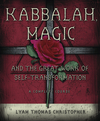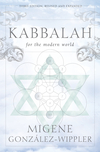Alchemical Transformation in the Golden Dawn

The Great Work is not an easy task for the human animal. It is the alchemical change from human to more-than-human, and it brings the student of the occult into a direct relationship with the predicament of mortality and with the compromises that he has made in order to survive in the material world. Plunging into these issues when most people would turn back, the student finds himself on a journey through disillusionment, self-doubt, and a dreadful loss of purpose—and possibly a journey that arrives at a new vista of life going far beyond what ordinary consciousness can fathom. In the process of this magical work, life usually gets worse before it gets better. The immortal Self awakened by the Golden Dawn's Kabbalistic techniques, by its very definition, brings with it a permanent joy and realization, yes, but these rewards are obtained by a journey through darkness. For the true thrust of the Golden Dawn comes as an assault from within. The Great Work brings forth an inner truth that destroys what we hold most dear. It dissolves from the inside the stranglehold that our biology has upon our spirit, subduing the animal and calling forth the god.
This is not good news to the ego, the "assumed identity" that you and I have adopted in order to survive in the world. We have spent at least eighteen years creating a fully functional personality capable of finding food and shelter, forming profitable relationships, and rearing offspring. To discover other possibilities beyond this baseline of existence poses a threat. The human animal fears the power of magic because, in its essence, magic seeks to supplant the animal motives with deeper ones. It seeks to penetrate beyond the boundaries of our daily survival drama. The fact that the body, which you and I work so hard to care for, is mortal—and obviously expendable in the hands of some deeper purpose—is the last reality we want to face!
For those of us morbid enough to value this kind of self-discovery there are available the hidden traditions that still maintain magical practices of self-transformation. The grade system of the Golden Dawn spells out one such program of practice for us. Granted, there are many modern-day offshoots of the Golden Dawn that have become too "respectable" and mainstream to explore the darkness of the human soul. They teach the rudiments of Kabbalah and Egyptology, revealing to us secret handshakes and granting us prestigious certificates, all while oozing an aura of empty mystery with every email. But for those of us who are looking for more than diplomas and historical trivia, there are the less impressive curricula that still teach the distasteful, hands-on work of killing and resurrecting the human animal.
To begin this not-so-glamorous process of transformation, the Golden Dawn student enters the first grade of the Outer Order: Neophyte. In most temples, the student's primary responsibility in this grade is to perform two exercises every day: the Lesser Banishing Ritual of the Pentagram (LBRP) and the Middle Pillar. He must also complete a small amount of reading, study, and group ritual, but these formalities, as important as they can be, are secondary to the actual daily practice of self-initiation.
The LBRP and Middle Pillar exercises restructure the psyche of the student and set the stage for the transformation process to begin. To do this, the LBRP creates a cleared "space" within the student's imagination. He draws a magic circle of protection, he intones Hebrew names of God, and he draws sigils with the intention of warding off the influences of the material world from his inner landscape. Following this, the Middle Pillar exercise invokes the highest, purest spiritual light from the student's divine aspect, drawing it downward into the cleared space and into his body, all the way to the feet. The student thereby identifies himself with a continuum of pure, unconditioned consciousness. He becomes the Middle Pillar of the Tree of Life. This is not so much pictured as an actual tree, but as a framework of interconnected spheres, which symbolizes the creation of the universe from spirit into matter.
Neophyte is a probationary grade. By creating this cleared space, the student introduces himself to future possibilities. If he isn't yet ripe for spiritual change, his ego has a chance to wage its war of resistance and win. And it often does win. The student who isn't ready for transformation either stops the process honestly and quits the Golden Dawn (usually for very "rational" reasons) or he joins the social club of New Age charlatans, accumulating grades, certificates, and a storehouse of impressive and useless information. Invisible to him are the students who proceed onward into the inner roller-coaster ride of the grades that follow. No one can fully understand the changes that come next, except those who have gone before.
The next step then is to jump-start the process of dissolving the personality. The student proceeds into the realm of the four Elemental grades:
In each of these grades, he uses Kabbalistic ritual to call forth one of the Four Elements, experiencing intimately its inner psychic correspondences. His personality becomes temporarily unbalanced, preoccupied with anything that corresponds to that Element. In Zelator (the Earth grade), for example, he feels the heaviness and the grit of life in the world. The physicality of everything around him comes into sharp focus. Even the supposedly exalted phenomenon of light can appear as darkness, as just one kind of brick in the tomb of matter. In Theoricus (the Air grade), thoughts and daydreams become overly pronounced. Elation, wonder, and the temptation to chase after glamorous images become commonplace. This gives the student a chance to reach a better understanding of his powers of imagination and his habits of thought, and to organize them and eliminate obsessions. In Practicus (the Water grade), the student gains gradual perspective over emotion and intuition, seeing these as a playing field that reveals the influence of higher forces, similar to the way that the surface of water that displays the influence of wind. And lastly, in the Fire grade, his ritual invocations fan the flames of his animal powers. Passions and instincts rise from below, and the old personality begins to burn away and disappear.
These four grades call forth, purify, and consolidate the each of the Elements, showing how these four come together to produce the illusion of the personality. The student discovers that his ego isn’t inherently real or composed of any singular essence, but rather that it is an arbitrary patchwork, woven together from separate Elemental threads. The false image of the ego shows itself for what it is, and the question of whether anything lies beyond its ingredients becomes serious.
A new perspective begins to dawn, and the student realizes that the real work hasn't even begun yet. The Elemental grades actually comprise the preliminary work, and a new landscape awaits him as he readies himself to embark on the Great Work itself.
The next task then is to balance the Elements—the facets of the personality—until their unity-in-diversity yields forth something more than the sum of its parts. The Portal Grade is therefore the last grade of the Outer Order, and it reverses the process of disintegration brought on via the Elemental-Grade exercises. All four Elements, which now stand in the four quarters (North, South, East, and West) symbolically untangled from one another, are brought back together meaningfully. This reintegration creates a healthy, sturdy base on which (or within which) to ignite the "oven" of the Great Work.
In Portal and the grades that follow, the language of alchemy, which has remained unreliable and even impenetrable till now, begins to make sense. The sturdy foundation (or vessel) that the student has built via the Elemental grades becomes tangible to the inner senses as a sort of inner, ethereal body, neither energy nor matter. In the midst of the four Elements the newborn adept can discern, for the first time perhaps, a sort of stasis field within which he can manipulate the three hidden alchemical principles: Mercury, Sulfur, and Salt. As he proceeds into adeptship, he graduates from working with the four visible Elements (the outer facets of the quintessence) to the three invisible principles of the Trinity (the inner aspects of the quintessence). These three supernal principles, expressed in their raw form, are the Salt, Sulfur, and Mercury of alchemy, and they comprise the intangible "guts" of the Four Elements, beneath the "skin" of tangible sensation. They must not be confused with the salt, sulfur, and mercury of common experience.
Into the stasis field—alchemical Salt—the magician begins to concentrate Mercury, the volatile, meandering aspect of mind, and Sulfur, discipline and concentration. His visualization ability now acts from a higher dimension, and it becomes nearly impossible to relay these deeper activities in words. But this kind of magical work has many symbols that attempt to explain it. The alchemists have sometimes represented the process as a crucified serpent, such as the serpent that Moses affixed to a cross in the desert. The cross represents the framework established by the preliminary work (Salt), the Serpent represents the volatile mind (Mercury), and the nails represent the fixation, the restraint and focus (Sulfur) applied to the volatile mind. The adept, in other words, is now capable of working with the quintessence. He can use visualization, breath, and ritual actions to contain his mind's volatile tendency (Mercury) within a localized area (Salt) and concentrate it to crystallize into manifestation (via the principle of Sulfur). The end product of this effort is the legendary philosopher's stone, none other than manifested spirit. His body begins to transform and take on the quality of invisible radiance.
Another image that represents this idea is that of the squared circle, common to Renaissance magicians. Renaissance humanists symbolized the unexpressed, divine self of an individual as a circle (Mercury). It's expression in matter, in the outer world, they visualized as a square (Salt). So, for the magician of antiquity, the squared circle—or circle with a square drawn around it—represented manifested spirit. Sulfur he represented as a point in the center of the circle. The point is the constant, balanced pressure (or meditation) that gradually pushes spiritual potential into matter, forcing it to crystallize and come forth.
To summarize then, the Work in the Golden Dawn's Outer Order is to dissolve the false personality and make it disappear. The Work in the Inner Order is to call forth the true "personality," to make it appear or express itself tangibly in the physical world. Though at first glance, the mysticism of the Golden Dawn seems to focus on dissolving the self into spirit, become more subtle and airy, it may come as a surprise to many that the further work of the inner order actually reverses this process such that the adept actively comes out into the world as a direct expression of his Higher Self. In the open air of awakening, his outer world of appearances is consumed by the Worlds within and by the very process of transformation itself. His very presence, without effort, begins to act as a catalyst for magical change wherever he goes.
About Lyam Thomas Christopher
Related Products


is subject to certain Terms and Conditions